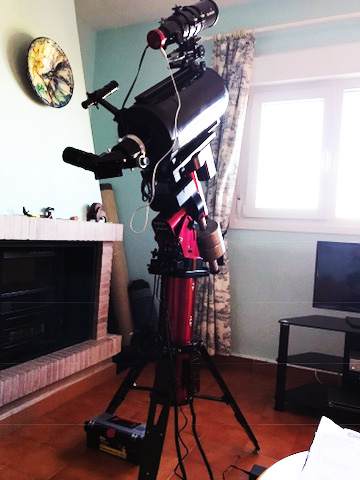Day 11 New Mexico Images, Canon 40D with 76mm lens images of Pleiades, M31, Double Cluster, Mizar and Alcor.
 Saturday, February 22, 2014 at 10:36AM
Saturday, February 22, 2014 at 10:36AM CLICK THROUGH THE LINKS ABOVE TO MOVE FORWARD OR BACK
A good day - completely blue sky. Currently taking an image (luminance only) of M91 using telescope T21 in New Mexico.
here it is
This is not a particularly bright galaxy and is frequently referred to as Messier's Missing Object as no-one could identify M91 until (in 1969) it was reasoned to be NGC 4548 - the above object observed by William Herschel in 1784. For the Wikipedia explanation of all this click here. The galaxy is clearly barred and is about 5 minutes across.
Here are the details of the imaging process starting up(focusing and pointing stage) (courtesy of itelescope.com)
Here is the technical data on T21 (courtesy of itelescope.com)
T21 has just become available again and I am currently taking a 5 minute exposure of M92 a globular cluster with a diameter of 14'.
Initial data from T21
and the image
I have cropped the original image.The globular cluster is only two-thirds of the size of its well known neighbour (both in Hercules) M13.
Just for comparison here is one of M13 that I took (remotely) earlier - I used the logarithmic function in IRIS to bring out the individual stars more clearly.
At 7.25 pm I plugged in the CGEm mount with the 4" refractor and the piggybacked Canon 40D. All I had to do was plug in - switch on the CGEM and the Canon, set the CGEM to the initial registration marks and tell it to use the previous settings, I then used the Sky software to slew the mount to Jupiter, switch on the Telrad and make a slight adjustment to centre Jupiter in the Telrad - then centre it in the 32mm eyepiece on the 4" refractor. I then synched Jupiter into the current TPoint model and Mapped the point in TPoint. Hopefully the mount will be sufficiently aligned to give good pointing accuracy. I aim to use the same lens as Day 9 but with a 76 mm setting on the lens instead of 38mm.
I took a quick snap of the telescope (using flash) while I am waiting for darkness to fall
I took an image (shown in monochrome) using the 76mm lens of the Pleiades. The image is absolutely crowded with stars in this 60 second image. The next stage for me is to take multiple exposures and stack them to see the result. I do not (yet) have an autoguider on this setup so long exposures are difficult. I will try multiple exposures at the next opportunity.
This is the negative of that image with image data
The 60s image below was taken of M31 - definitely worth a multiple exposure.
The next image I took was of the Double Cluster in Perseus which is shown below with North to the right.
The upper cluster in this image is NGC 884 and the lower image is NGC 869. The image is 60 seconds at ISO 800 with the 76mm lens at f 5.6.
I slewed the telescope to Mizar in the Great Bear or Plough and took the image below.
 [Your Name Here] | Comments Off |
[Your Name Here] | Comments Off | 







